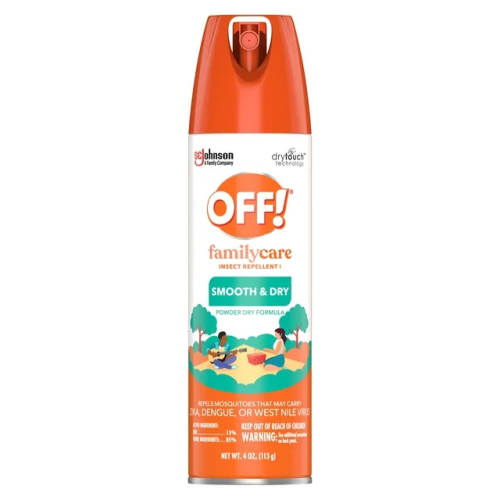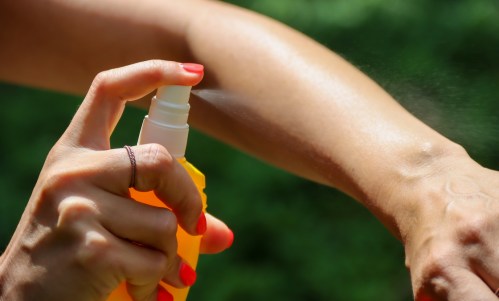Our editors independently select these products. Making a purchase through our links may earn Well+Good a commission
When you’re pregnant, it’s important to do what you can to ensure a healthy pregnancy. This will involve thinking twice about what you put on your skin and opting to use pregnancy-safe skin-care products—bug spray included.
Experts in This Article
associate professor of dermatology at Mount Sinai
board-certified dermatologic surgeon at Shafer Clinic Fifth Avenue in New York City
board-certified OB/GYN and chief of staff at the Water Reed Medical Medical Center at Viva Life Health Hub in San Diego
board-certified dermatologist at Medical Dermatology and Cosmetic Surgery in New York
naturopathic doctor and health director of Rose Health Clinic in Toronto, Canada
naturopathic doctor and doula based in Ontario, Canada
Certain ingredients found in bug spray—such as DEET—can be absorbed into the skin, and if these ingredients aren’t deemed safe for use when pregnant, it can be potentially harmful to a pregnant person’s developing baby, especially if used in high concentrations. “As a product is absorbed into the skin, it will usually end up in our bloodstream and then get shared with a growing baby via the placenta and/or umbilical cord,” says Sarah Connors, ND, a naturopathic doctor and doula based in Ontario, Canada. “Keeping in mind that any products we use end up getting shared with our unborn children makes it that much more important to be aware of the ingredients in that product.”
Still, it’s essential to use bug spray to protect against itchy bites and insect-borne diseases like Zika and West Nile virus, which can also put pregnant people and their offspring at risk of harm. Fortunately, there are options that are safe and effective to use when pregnant.
Best pregnancy-safe bug sprays, at a glance
- A DEET bug spray that offers long-lasting protection: Off!, FamilyCare Insect Repellent, $7
- A DEET bug spray for shorter outdoor excursions: Cutter, All Family Insect Repellent, $12
- An odorless, long-lasting picaridin bug spray: Sawyer, Picaridin Insect Repellent, $16
- A dermatologist-favorite picaridin bug spray: Avon, Skin So Soft Bug Guard Plus Picaridin, $17
- A plant-based bug spray with OLE: Repel, Plant-Based Lemon Eucalyptus Insect Repellent, $5
- A pregnancy-safe insect repellent for clothes: Sawyer, Permethrin Clothing Insect Repellent, $12
Is it safe to use bug spray with DEET when pregnant?
According to the Centers for Disease Control and Prevention (CDC), DEET is safe for pregnant (and breastfeeding) people when used as directed.
However, that doesn’t mean there is no cause for concern. 10 percent of the chemical can enter the bloodstream through the skin, per the National Institutes of Health, and some studies have considered DEET to be unsafe for pregnant people and their babies. For example, one 2024 study published in iScience found that high DEET exposure had a negative impact on Caenorhabditis elegans, a worm species that has many genes in common with humans. DEET was found to affect meiosis, the cell division in which sperm and eggs are made, in C. elegans—and, in humans, this could potentially lead to miscarriage and stillbirth.
That said, when considering the study, it’s important to keep in mind that the worms were exposed to DEET for 24 hours at a time—and, in an interview with Harvard Medical School, the study’s senior author Monica Colaiácovo mentioned that this is a level of exposure that may not be applicable to most people, while also noting that there are “metabolic and physiological differences between worms and humans.” As such, it’s difficult to know whether DEET will cause reproductive issues in humans until more studies have been conducted in the future.
Unfortunately, there is a lack of research on the effects of DEET on humans, and in large part because of ethical concerns, but existing research conducted on humans has proven that using bug repellents with DEET isn’t likely to harm developing babies. A randomized trial of 897 women in Thailand, published in 2001, found that the pregnant women who used DEET didn’t experience complications around pregnancy and childbirth. (A 2010 study of 150 pregnant women in New Jersey found similar results.)
Kelly Elmore, MD, board-certified OB/GYN and chief of staff at the Water Reed Medical Medical Center at Viva Life Health Hub in San Diego, considers DEET to be safe in low concentrations for pregnant people. “The risk of harm to a mom and baby using DEET is lower than using no bug repellent and contracting malaria or Zika,” she says. However, she adds, “If you live in an area with a low risk of malaria or Zika, consider using DEET-free options.” On the other hand, Dendy Engelman, MD, FACSM, FAAD, board-certified dermatologic surgeon at Shafer Clinic Fifth Avenue in New York City, recommends steering clear of DEET altogether, as it can cause skin irritation and allergic reactions in some individuals.
If and when considered a DEET-free bug repellent, use options formulated with picaridin or oil of lemon eucalyptus (or its synthetic derivative, PMD), which the CDC says are safe to use when pregnant. (Note: These ingredients haven’t been studied in humans. With this in mind, it’s best to speak to your OB/GYN or dermatologist to determine whether a particular bug spray is right for you.)
What to look for in a pregnancy-safe bug spray
Low concentrations of DEET
DEET is found in many bug sprays because it can effectively repel bugs like mosquitoes, ticks, chiggers, and biting flies, and per the CDC, it’s safe for most individuals, including pregnant and nursing people. However, it isn’t typically recommended for children under two months of age. Olivia Rose, ND, naturopathic doctor and health director of Rose Health Clinic in Toronto, Canada, recommends using bug sprays with DEET concentrations under 30 percent for optimal safety and protection during pregnancy. There are formulas with DEET concentrations as low as five percent; however, products with lower DEET percentages will have to be reapplied more often than ones with higher concentration of the chemical. (For reference, a 10 percent DEET formula will offer protection for up to six hours, whereas a higher-percentage DEET formula will repel bugs for much longer.)
DEET Alternatives
If, for any reason, you’d prefer a DEET-free bug repellent, there are alternatives:
- Picaridin: Picaridin is a synthetic compound that has been found to be as effective as DEET at protecting against mosquitoes, ticks, and other bugs. According to Dr. Elmore, “It’s safe for use during pregnancy, so long as it’s used according to product directions.” Formulas with a concentration of up to 20 percent picaridin are effective and, per the CDC, are safe for pregnant people and children two years old and older. A 20 percent picaridin formula will typically repel bugs for up to 12 hours, though there are options available in lower concentrations—keeping in mind that a higher percentage of picaridin will offer longer-lasting protection.
- Oil of lemon eucalyptus (or PMD): Oil of lemon eucalyptus, or its synthetic version, PMD, has been deemed as a safe and effective alternative to DEET or picaridin for pregnant people. “Some testing has shown that concentrations of 20 to 26 percent PMD may perform as well as 15 to 20 percent DEET against both mosquitoes and ticks,” says Dr. Connors. Just keep in mind that “PMD’s maximum protection time against mosquitoes and ticks is shorter than DEET,” she says—and for this reason, it will require frequent reapplication. (Note that the CDC does not recommend using oil of lemon eucalyptus or PMD on children under three years old.)
Regardless of your preference, you’ll want a bug repellent that is registered with the Environmental Protection Agency (EPA) to ensure that a given product is both safe and effective to use on the skin.
Shop the best pregnancy-safe bug sprays

A DEET bug spray that offers long-lasting protection: Off!, FamilyCare Insect Repellent — $7.00
Active ingredient: 15% DEET
This bug spray is formulated with 15 percent DEET, which as Dr. Rose mentioned, isa safe concentration for pregnant people. The EPA-registered formula can repel mosquitos, ticks, chiggers, gnats, and biting flies for up to six hours, and its powder-dry formula is designed to feel lightweight and non-sticky on the skin. Note that though the brand indicates that it can be sprayed onto clothing, it can damage items made from synthetic materials.
Coverage: Up to six hours of protection
EPA-registered: Yes
Size: 4 oz
Pros:
- Lightweight- and non-sticky formula
- Formulated with 15 percent DEET, making it safe for pregnant people to use
Cons:
- It can damage synthetic fabrics

A DEET bug spray for shorter outdoor excursions: Cutter, All Family Insect Repellent — $12.00
Active ingredient: 7% DEET
This insect repellent is formulated with just seven percent of DEET, making it ideal for those who want an effective product but also want to limit their exposure to the chemical. The EPA-registered formula is said to protect against mosquitos, ticks, chiggers, gnats, biting flies, and fleas, but the manufacturer doesn’t not indicate exactly how long it will offer protection. However, since it only contains seven percent of DEET, it’s likely it will have to be reapplied more frequently compared to the previous pick.
Coverage: Not specified
EPA-registered: Yes
Size: 6 oz
Pros:
- Formulated with low percentage of DEET
- Lightweight and non-sticky formula
Cons:
- Frequent application necessary
- It can damage synthetic fabrics

An odorless, long-lasting picaridin bug spray: Sawyer, Picaridin Insect Repellent — $16.00
Active ingredient: 20% picaridin
Formulated with 20 percent picaridin, this EPA-registered insect repellent protects against mosquitos and ticks for up to12 hours and biting flies for up to eight hours, making it the long-lasting option on the list. It also has Dr. Garshick’s stamp of approval for its non-sticky and fragrance-free formulation—ideal for those who are sensitive to smells. In addition to the four-ounce bottle (pictured above), it also comes in a three-ounce bottle and a four-ounce two-pack.
Coverage: Up to 12 hours of protection
EPA-registered: Yes
Size: 4 oz (also available in 3 oz)
Pros:
- Fragrance-free formula
- Offers long-lasting protection of up to 12 hours
Cons:
- It isn’t recommended for kids under two years of age

A dermatologist-favorite picaridin bug spray: Avon, Skin So Soft Bug Guard Plus Picaridin — $17.00
Originally $20, now $17
Active ingredient: 10% picaridin
Dr. Elmore and Dr. Engelman both recommend this DEET-free insect repellent. “This spray utilizes picaridin instead of DEET to safely repel insects,” says Dr. Engelman. “It is also low-odor and dermatologist-tested so it’s less likely to lead to irritation.” Specifically, it’s formulated with 10 percent of picardian to repel mosquitoes, ticks, gnats, and biting flies for up to eight hours. Also on the ingredients list is vitamin E and aloe vera to keep “skin so soft.”
Coverage: Up to eight hours of protection
EPA-registered: Yes
Size: 8 oz
Pros:
- Recommended by Dr. Elmore and Dr. Engelman
- Repels insects for up to eight hours
Cons:
- Formula isn’t fragrance-free

A plant-based bug spray with OLE: Repel, Plant-Based Lemon Eucalyptus Insect Repellent — $5.00
Active ingredient: 30% oil of lemon eucalyptus
Infused with 30 percent of oil of lemon eucalyptus, this insect repellent provides protection from mosquitoes, ticks, and gnats—and it comes with the recommendation of Dr. Engelman. “This product is great because it is DEET-free and claims to repel insects, including disease-transmitting mosquitoes that pose an extra risk to pregnant women, for up to six hours. The product is EPA-registered to ensure that it’s both safe and effective—keeping in mind that it isn’t recommended by the CDC for children under three years of age.
Coverage: Up to six hours of protection
EPA-registered: Yes
Size: 4 oz
Pros:
- A safe and effective alternative to DEET- and picaridin-formulated bug repellent
- Budget-friendly
Cons:
- Requires reapplication after six hours
- It isn’t recommended for children under three years of age

An insect repellent for clothes: Sawyer, Permethrin Clothing Insect Repellent — $12.00
Active ingredient: 0.5% permethrin
In addition to using insect repellent, Dr. Elmore recommends using a repellent for clothing, especially when spending time outdoors. This bug spray is formulated with permethrin, a potent chemical that keeps mosquitoes, ticks, and other bugs away from fabrics. According to Dr. Elmore, “permethrin is safe for pregnant people, so long as it’s used only on clothing and it’s not directly applied onto the skin.” Plus, it offers protection for up to six weeks or six washes.
Coverage: Up to six weeks of protection
Size: 9 oz (also available in 18 oz)
Pros:
- Repels insects from clothes for up to six weeks or six washes
- Available in multiple formats and sizes
Cons:
- Not for use on skin
How to apply bug spray
When using bug spray, you want to make sure that you’re using it correctly to maximize its effectiveness and ensure safety of use. According to the EPA, it’s important to read the label directions—and only reapply as needed—to exposed skin and clothes. If you’ll also be using sunscreen, you’ll want to apply bug repellent after SPF application. Conversely, you’ll want to avoid using bug spray on cuts, wounds, and irritated skin, as well as under clothing. When using on the face, “it’s best to avoid spraying your face directly,” says Marisa Garshick, MD, FAAD, board-certified dermatologist at Medical Dermatology and Cosmetic Surgery in New York. “It’s recommended to first spray the palm of the hand and then apply [to the face].”
TIP
If using DEET bug repellent, it’s important to note that it can damage plastic and synthetic fabrics. As such, you may want to opt for a DEET-free insect repellent if you want to apply it onto clothes made of these materials.
Is being bitten by mosquitoes more dangerous when pregnant?
If bitten by a mosquito carrying viruses, it can pose a potential health risk to you and your baby. According to the CDC, viruses like the Zika virus and West Nile virus, can be passed to a baby in the womb.
Will bug spray protect against Zika virus?
A bug spray will undoubtedly offer protection against insect bites, and thereby, reduce the risk of contracting insect-borne viruses like Zika. That said, it isn’t foolproof, says Angela Lamb, MD, system vice chair of clinical operations and strategist and associate professor of dermatology at Mount Sinai. With this in mind, she recommends that pregnant people wear protection, and if possible, avoid high Zika-prevalence areas, in addition to using bug repellent.
Sign up for the Well+Good SHOP Newsletter
Get exclusive deals on wellness, beauty, fitness, and food products that have been hand-picked by our editors.
Got it, you've been added to our email list.










